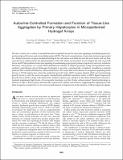Autocrine-controlled formation and function of tissue-like aggregates by hepatocytes in micropatterned hydrogel arrays
Author(s)
Williams, Courtney M.; Mehta, Geeta; Peyton, Shelly R.; Zeiger, Adam Scott; Van Vliet, Krystyn J.; Griffith, Linda G.; ... Show more Show less
DownloadWilliams-2010-Autocrine-controlled formation and function of tissue-like aggregates by hepatocytes in micropatterned hydrogel arrays.pdf (1010.Kb)
PUBLISHER_POLICY
Publisher Policy
Article is made available in accordance with the publisher's policy and may be subject to US copyright law. Please refer to the publisher's site for terms of use.
Terms of use
Metadata
Show full item recordAbstract
The liver carries out a variety of essential functions regulated in part by autocrine signaling, including hepatocyte-produced growth factors and extracellular matrix (ECM). The local concentrations of autocrine factors are governed by a balance between receptor-mediated binding at the cell surface and diffusion into the local matrix and are thus expected to be influenced by the dimensionality of the cell culture environment. To investigate the role of growth factor and ECM-modulated autocrine signaling in maintaining appropriate primary hepatocyte survival, metabolic functions, and polarity, we created three-dimensional cultures of defined geometry using micropatterned semisynthetic polyethylene glycol–fibrinogen hydrogels to provide a mechanically compliant, nonadhesive material platform that could be modified by cell-secreted factors. We found that in the absence of exogenous peptide growth factors or ECM, hepatocytes retain the epidermal growth factor (EGF) receptor ligands (EGF and transforming growth factor-α) and the proto-oncogenic mesenchymal epithelial transition factor (c-MET) ligand hepatocyte growth factor (HGF), along with fibronectin. Further, hepatocytes cultured in this three-dimensional microenvironment maintained high levels of liver-specific functions over the 10-day culture period. Function-blocking inhibitors of α5β1 or EGF receptor dramatically reduced cell viability and function, suggesting that signaling by both these receptors is needed for in vitro survival and function of hepatocytes in the absence of other exogenous signals.
Date issued
2011-03Department
Massachusetts Institute of Technology. Center for Gynepathology Research; Massachusetts Institute of Technology. Department of Biological Engineering; Massachusetts Institute of Technology. Department of Materials Science and Engineering; Massachusetts Institute of Technology. Department of Mechanical EngineeringJournal
Tissue Engineering. Part A
Publisher
Mary Ann Liebert, Inc.
Citation
Williams, Courtney M. et al. “Autocrine-Controlled Formation and Function of Tissue-Like Aggregates by Primary Hepatocytes in Micropatterned Hydrogel Arrays.” Tissue Engineering Part A 17.7-8 (2011) : 1055-1068. © Mary Ann Liebert, Inc.
Version: Final published version
ISSN
1937-3341
1937-335X